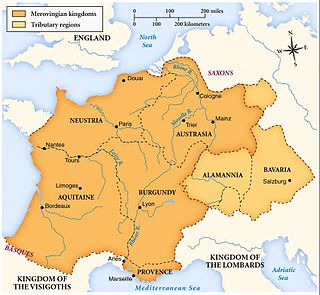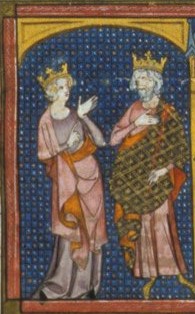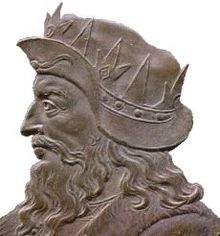
The Merovingian dynasty was the ruling family of the Franks from around the middle of the 5th century until 751. They first appear as "Kings of the Franks" in the Roman army of northern Gaul. By 509 they had united all the Franks and northern Gallo-Romans under their rule. They conquered most of Gaul, defeating the Visigoths (507) and the Burgundians (534), and also extended their rule into Raetia (537). In Germania, the Alemanni, Bavarii and Saxons accepted their lordship. The Merovingian realm was the largest and most powerful of the states of western Europe following the breaking up of the empire of Theodoric the Great.

Clovis was the first king of the Franks to unite all of the Frankish tribes under one ruler, changing the form of leadership from a group of petty kings to rule by a single king and ensuring that the kingship was passed down to his heirs. He is considered to have been the founder of the Merovingian dynasty, which ruled the Frankish kingdom for the next two centuries. Clovis is important in the historiography of France as "the first king of what would become France".

Childeric I was a Frankish leader in the northern part of imperial Roman Gaul and a member of the Merovingian dynasty, described as a king, both on his Roman-style seal ring, which was buried with him, and in fragmentary later records of his life. He was father of Clovis I, who acquired effective control over all or most Frankish kingdoms, and a significant part of Roman Gaul.

Merovech was the ancestor of the Merovingian dynasty. He was reportedly a king of the Salian Franks, but records of his existence are mixed with legend and myth. The most important written source, Gregory of Tours, recorded that Merovech was said to be descended from Chlodio, a roughly contemporary Frankish warlord who pushed from the Silva Carbonaria in modern central Belgium as far south as the Somme, north of Paris in modern-day France. His supposed descendants, the kings Childeric I and Clovis I, are the first well-attested Merovingians.

The Kingdom of the Franks, also known as the Frankish Kingdom, the Frankish Empire or Francia, was the largest post-Roman barbarian kingdom in Western Europe. It was ruled by the Frankish Merovingian and Carolingian dynasties during the Early Middle Ages. Francia was among the last surviving Germanic kingdoms from the Migration Period era.

Pharamond, also spelled Faramund, is a legendary early king of the Franks, first referred to in the anonymous 8th-century Liber Historiae Francorum, which depicts him as the first king of the Franks.
Marcomer, also spelled Marcomeres, Marchomer, or Marchomir was a Frankish Dux in the late 4th century who assisted in an invasion of the Roman Empire in the year 388, as the usurper and leader of the whole of Roman Gaul, Magnus Maximus, was surrounded by Theodosius I in the city of Aquileia.

The Salian Franks, also called the Salians, were a northwestern subgroup of the early Franks who appear in the historical record in the fourth and fifth centuries. They lived west of the Lower Rhine in what was then the Roman Empire and today the Netherlands and Belgium.

Ripuarian or Rhineland Franks were one of the two main groupings of early Frankish people, and specifically it was the name eventually applied to the tribes who settled in the old Roman territory of the Ubii, with its capital at Cologne on the Rhine river in modern Germany. Their western neighbours were the Salii, or "Salian Franks", who were named already in late Roman records, and settled with imperial permission within the Roman Empire in what is today the southern part of the Netherlands, and Belgium, and later expanded their influence into the northern part of France north of the Loire river, creating the Frankish empire of Francia.

The Franks were a western European people during the Roman empire and early middle ages. They began as a Germanic people who lived near the Lower Rhine, on the northern continental frontier of the empire, but they successfully expanded their power and influence during the Middle Ages, until much of the population of western Europe, particularly in or near France, were commonly described as Franks, for example in the context of their joint efforts during the crusades starting in the 11th century. This expansion came about because the romanized Frankish dynasties based within the collapsing Western Roman Empire first became the rulers of the whole region between the rivers Loire and Rhine, and then subsequently imposed power over many other post-Roman kingdoms both inside and outside the old empire.
Sunno was a leader (dux) of the Franks in the late 4th century who invaded the Roman Empire in the year 388 when the usurper and leader of the whole of Roman Gaul, Magnus Maximus was surrounded in Aquileia by Theodosius I.

Cambrésis is a former pagus, county and prince-bishopric of the medieval Holy Roman Empire that was annexed to the Kingdom of France in 1679. It is now regarded as one of the "natural regions" of France, and roughly equivalent to the Arrondissement of Cambrai in department Nord. The capital of Cambrésis was Cambrai. Originally ruled by a dynasty of counts, Cambrésis became a prince-bishopric in 1007, comparable to the Prince-Bishopric of Liège and the Prince-Bishopric of Utrecht. It encompassed the territory in which the bishop of Cambrai had secular authority.

Basina or Basine was remembered as a queen of Thuringia in the middle of the fifth century, by much later authors such as especially Gregory of Tours. However, because Gregory described her family's kingdom of Thuringia as being on the Gaulish or western side of the river Rhine, it is sometimes thought to be the Civitas Tungrorum, which is now Belgium.
The pagan religion of the Germanic tribal confederation of the Franks has been traced from its roots in polytheistic Germanic paganism through to the incorporation of Greco-Roman components in the Early Middle Ages. This religion flourished among the Franks until the conversion of the Merovingian king Clovis I to Nicene Christianity, though there were many Frankish Christians before that. After Clovis I, Frankish paganism was gradually replaced by the process of Christianisation, but there were still pagans in the late 7th century.
Bisinus was the king of Thuringia in the 5th century AD or around 500. He is the earliest historically attested ruler of the Thuringians. Almost nothing more about him can be said with certainty, including whether all the variations on his name in the sources refer to one or two different persons. His name is given as Bysinus, Bessinus or Bissinus in Frankish sources, and as Pissa, Pisen, Fisud or Fisut in Lombard ones.

Silva Carbonaria, the "charcoal forest", was the dense old-growth forest of beech and oak that formed a natural boundary during the Late Iron Age through Roman times into the Early Middle Ages across what is now western Wallonia. The Silva Carbonaria was a vast forest that stretched from the rivers Zenne and the Dijle in the north to the Sambre in the south. Its northern outliers reached the then marshy site of modern Brussels.
Ragnachar or Ragnarius was a Frankish petty king (regulus) who ruled from Cambrai. According to Gregory of Tours, Ragnachar "was so unrestrained in his wantonness that he scarcely had mercy for his own near relatives".
Dispargum could refer to either the city of Duisburg on the Rhine, or the village of Duisburg near Brussels, or the city of Diest.

The Battle of Vicus Helena was a clash between Salian Franks led by Chlodio and Roman soldiers commanded by general Flavius Aetius; the latter were victorious. It is attested in a limited number of late Roman and early Medieval sources, and reportedly occurred in or around the year 448 in the unidentified place of Vicus Helena somewhere in the Civitas Atrebatium, modern Artois.















